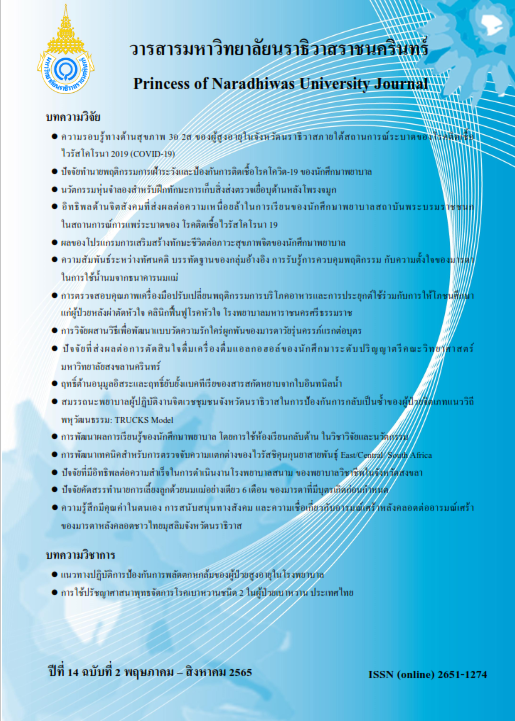Antioxidant and Antimicrobial Activities of Leaves Crude Extracts of Lagerstroemia speciosa (L.) Pers
Keywords:
Lagerstroemia speciosa (L.) Pers, Antioxidant activity, Antimicrobial activityAbstract
Medicinal plants are one of the most significant natural sources of antioxidant capacity and antimicrobial agents. Lagerstroemia speciosa (L.) Pers is a medicinal plant that has various pharmacological activities and has been used for a long time in Southeast Asia. Therefore, the objectives of this research were to investigate antioxidant and antimicrobial activities of crude ethanolic extracts of Lagerstroemia speciosa (L.) Pers. leaves. Antioxidant activity was determined by DPPH assay method. The result showed that the IC50 of crude ethanolic extracts of Lagerstroemia speciosa (L.) Pers. leaves was 11.23 μg/ml. Antimicrobial activity was evaluated by agar well diffusion method. The result showed that it exhibited against gram-positive bacteria such as Micrococcus luteus TISTR884, Staphylococcus aureus TISTR517, Methicillin-resistant S. aureus 142 (MRSA142) and against gram-negative bacteria, Pseudomonas aeruginosa TISTR146. Moreover, it shown the highest activity against M. luteus TISTR884 with the inhibition zone as 28.30±0.060 mm.
References
Ambujakshi, H.R., Surendra, V., Haribabu, T., & Divakar, G. (2009). Antibacterial activity of leaves of Lagerstroemia speciosa (L) Pers.). Journal of Pharmacy Research, 2(6), 1028.
Akova, M. (2016). Epidemiology of antimicrobial resistance in bloodstream infections. Virulence, 7(3), 252-266.
Bajpai, V.K., Rahman, A., Dung, N.T., Huh, M.K., & Kang, S.C. (2008). In-vitro inhibition of food spoilage and food borne pathogenic bacteria by essential oil and leaf extracts of Magnolia liliflora. Desr. J. Journal of Food Science, 73(6), M314-M320.
Chen, M.X., Huo, J.M., Hu, J., Xu, Z.P., & Zhang, X. (2018). Amaryllidaceae alkaloids from Crinum latifolium with cytotoxic, antimicrobial, antioxidant, and anti-inflammatory activities. Fitoterapia, 130, 48-53.
Critchfield, J.W., Butera, S.T., & Folks, T.M. (1996). Inhibition of HIV activation in latently infected cells by flavonoid compounds. AIDS Research and Human Retroviruses, 12(1), 39-46.
Gornganok, P., Kruawan, H., Nattanicha, K., Manutsanun, S., & On-Anong, S. (2020). Antibacterial and Antioxidant Capacities of Tanjong (Mimusops elengi L.) Leaf Extract. Princess of Naradhiwas University Journal, 12(1), 140-149.
Gorniak, I., Bartoszewski, R., & Króliczewski, J. (2019). Comprehensive review of antimicrobial activities of plant flavonoids. Phytochemistry Reviews, 18, 241-272.
Hayriye, C.K., & Melissa, C.N. (2015). Antimicrobial efficacy of plant phenolic compounds against Salmonella and Escherichia coli. Food Bioscience, 11, 8-16.
Javed, B., Nawaz, K., & Munazir, M. (2020). Phytochemical Analysis and Antibacterial Activity of Tannins Extracted from Salix alba L. Against Different Gram-Positive and Gram-Negative Bacterial Strains. Iranian Journal of Science and Technology, Transactions A: Science, 44, 1303-1314.
Kanya, P., & Pornpimon, K. (2015). Antibacterial activity of ethanolic extracts of Houttuynia cordata Thunb., Allium sativum and Amomum krervanh Pierre on some bacteria. Huachiew Chalermprakiet Science and Technology Journal, 1(2), 56-65.
Lewis, K., & Ausubel, F.M. (2006). Prospects for plant derived antibacterials. Nature Biotechnology, 24(12), 1504-1507.
Liguori, I., Russo, G., Curcio, F., Bulli, G., Aran, L., Morte, D.D., … Abete, P. (2018). Oxidative stress, aging, and diseases. Clinical Interventions in Aging, 13, 757-772.
Lima, M.C., Paiva de Sousa, C., Fernandez-Prada, C., Harel, J., Dubreuil, J.D., & de Souza E.L. (2019). A review of the current evidence of fruit phenolic compounds as potential antimicrobials against pathogenic bacteria. Microbial Pathogenesis, 130, 259-270.
Mohammed, S.O., Abuzeid, N.M., Abdelghani, S., & Eltayeb, L.B. (2021). In-Vitro Antibacterial Activity of crude Garlic (Allium Sativum) Extract Against Clinical Isolates of Methicillin Resistant Staphylococcus aureus. Biomedical and Pharmacology Journal, 14(3), 1449-1457.
Mousa, A.M, El-Sammad, N.M., Abdel-Halim, A.H., Anwar, N., Khalid, W.K.B., Nawwar, M., … Hassan, S.K. (2019). Lagerstroemia speciosa (L.) Pers Leaf Extract Attenuates Lung Tumorigenesis via Alleviating Oxidative Stress, Inflammation and Apoptosis. Biomolecules, 9(12), 871.
Murugan, N.B., Mishra, B.K., & Paul, B. (2018). Antioxidant and antibacterial evaluation of medicinal plants used in the starter culture (Wanti) of fermented rice beverage in West Garo hills, Meghalaya. Journal of Pharmacognosy and Phytochemistry, 7(1), 1669-1674.
Myint, P.P., Soe, M.T., & Hlaing, H.H. (2017). A study of phytoconstituents, α-glucosidase inhibitory effect and antioxidant activity of Lagerstroemia speciosa L. Leaf and fruit. Journal of Pharmacognosy and Phytochemistry, 6(4), 528-533.
Nasrin, F., Ahmad, S. & Kamrunnahar. (2012). Evaluation of antimicrobial, antioxidant and cytotoxic activities of methanolic extracts of Lagerstroemia speciosa leaves and barks. Journal of Applied Pharmaceutical Science, 2(10), 142-147.
On-Anong, S., Gornganok, P., Kolip, P., & Charuwan, D. (2019). Antibacterial and Antioxidant Activity of Nam-Nam Fruit. Extract. Princess of Naradhiwas University Journal, 11(2), 156-167.
Pandey, A., & Tripathi, S. (2014). Concept of standardization, extraction and pre phytochemical screeningstrategies for herbal drug. Journal of Pharmacognosy and Phytochemistry, 2(5), 115-119.
Safari, M., & Asbchin, S.A. (2019). Evaluation of antioxidant and antibacterial activities of methanolic extract of medlar (Mespilus germanica L.) leaves. Biotechnology & Biotechnological Equipment, 33(1), 372-378.
Shi, L., Zhang, W., Zhou, Y.Y., Zhang, Y.N., Li, J.Y., Hu, L.H., …Li, J. (2008). Corosolic acid stimulates glucose uptake via enhancing insulin receptor phosphorylation. European Journal of Pharmacology, 584(1), 21-29.
Suzuki, Y., Unno, T., Ushitani, M., Hayashi, K., & Kakuda, T. (1999). Antiobesity activity of extracts from Lagerstroemia speciosa L. leaves on female KK-Ay mice. Journal of Nutritional Science Vitaminology, 45(6), 791-795.
The Botanical Garden Organization. (2015). Lagerstroemia speciosa Pers. Retrived Jan 20, 2022, from http://www.qsbg.org/database/botanic_book%20full%20option/search_detail.asp? botanic _id=1198
Unno, T., Sakane, I., Masumizu, T., Kohno, M., & Kakuda, T. (1997). Antioxidative activity of water extracts of Lagerstroemia speciosa leaves. Bioscience, Biotechnology, and Biochemistry, 61(10), 1772-1774.
Unno, T., Sugimoto, A., & Kakuda, T. (2004). Xanthine oxidase inhibitors from the leaves Lagerstroemia speciosa (L.) Pers. Journal of Ethnopharmacology, 93(2-3), 291-295.
Winnie, C.M., Isabel, N.W., & Josphat, C.M. (2019). Antibacterial saponins from the leaves of Polyscias fulva (Araliaceae). African Journal of Biotechnology, 18(19), 390-398.
Woratouch, T., Thatree, P., & Suchada, S. (2011). Pharmacognostic evaluations of Lagerstroemia speciosa leaves. Journal of Medicinal Plant Research, 5(8), 1330-1337.
Yamaguchi, Y., Yamada, K., Yoshikawa, N., Nakamura, K., Haginaka, J., & Kunitomo, M. (2006). Corosolic acid prevents oxidative stress, inflammation and hypertension in SHR/NDmcr-cp rats, a model of metabolic syndrome. Life Sciences, 79(26), 2474-2479.
Additional Files
Published
How to Cite
Issue
Section
License
Copyright (c) 2022 Princess of Naradhiwas University Journal

This work is licensed under a Creative Commons Attribution-NonCommercial-NoDerivatives 4.0 International License.




